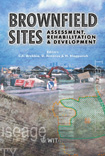Fugacity Framework: Web Access And Implementation For Site Assessment And Rehabilitation
Price
Free (open access)
Transaction
Volume
55
Pages
Published
2002
Size
698 kb
Paper DOI
10.2495/BF020371
Copyright
WIT Press
Author(s)
R. C. Sims, J. L. Sims, A. S. Gibbons, M. R. Baugh, M. McKonkie, J. K. Nieman, & W. J. Grenney
Abstract
Fugacity framework: web access and implementation for site assessment and rehabilitation R.C. Sims, J.L. Sims, A.S. Gibbons, M.R. Baugh, M. McKonkie, J.K. Nieman, and W.J. Grenney Utah State University, Logan, Utah, United States of America Abstract The fugacity-framework addresses multiple-media and multiple contaminant aspects of environmental site assessment. A U.S. EPA database of priority chemicals has been linked to the fugacity model for assessment of contaminant sources, transport and transformation, and exposure. Site-specific data are provided by the user. This tool provides a way for managers to visualize the behavior of toxic chemicals at a contaminated site, the effect of site-specific characteristics on contaminant distribution, the behavior of daughter products of degradation, and the associated risks to humans and the environment. The framework can be used to make decisions regarding protection of public health and the environment, site rehabilitation, and the sustainable development and economic recovery of impacted sites. The fugacity framework can be accessed at http://www,engineering.usu.edu/uwrl/,Utah Water Research Laboratory. 1 Introduction Contaminated site rehabilitation involves an assessment of contaminant distribution from source(s) to receptor(s) that may include humans and the environment. Contaminants within sources generally spread through release and migration that expands to larger volumes of soil, water, air, and/or oil phases that result in large-scale exposure and receptor scenarios (Figure 1) that must be controlled through costly risk management technologies of containment,
Keywords




